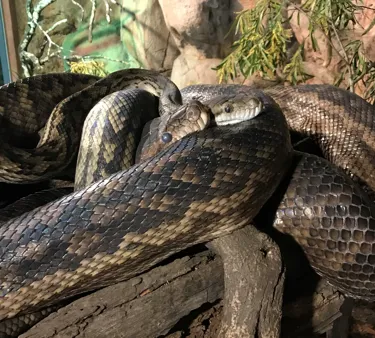Ronny, our largest snake turns blue for World Snake Day
- Wednesday 14th July 2021
- Snakes

Please note that Ronny is no longer in our attraction.
Ronny the Scrub Python is preparing for the fascinating natural phenomenon known as ‘turning blue’ ahead of World Snake Day this Friday 16th July.
Weighing in at 20kg, the five-metre long Scrub Python appropriately named Ronny after World Champion Body Builder, Ron ‘Big Ronny’ Coleman is part of the largest species of python in Australia.
The natural process of turning blue is truly impressive to witness in a snake of Ronny’s size! Turning blue is a phrase used to explain the shedding process snakes go through whereby the slithery reptile’s eyes foreshadow the change of skin that's about to occur. When a snake’s eyes turn a milky blue colour, it signifies their spectacles are about to shed which starts the process of their entire body shedding!
Snake’s skin doesn’t grow which is why the shedding process is an important part of a snake’s growth as they outgrow their skin. The keepers also use the snake’s shed skin as part of Ronny’s health checks as it provides valuable information such as signs of dehydration.
It’s amazing to see Ronny’s skin shed in one entire piece so we often keep it as a way to help educate guests who can touch and hold the 5-metre long shed skin when they visit.
What is World Snake Day? <H2>
Taking place annually on 16th July, World Snake Day is a global celebration of snakes and their diversity, providing a great opportunity to highlight unique facts about snakes. WILD LIFE Sydney Zoo keeper Lauren Hughes has provided some of her favourite snake facts for World Snake Day:
5 Unique Snake Facts: <H2>
- Scrub pythons are also known as Amethystine Pythons due to the Amethyst—like shimmer of their scales in the sun
- Snakes shed an entire body's worth of scales; including their spectacles (for a snake the size of Ronny that’s a lot of scales!)
- Snakes don’t have ears, so they rely heavily on scent and vibrations of the ground. Snakes smell using their forked-tongue.
- Myth: Snakes 'dislocate' their jaws; Fact: Snakes stretchy ligaments in their jaw, backward-facing teeth and a lower jaw that isn’t joined in the middle allowing them to ‘walk’ their stretchy jaws around their prey
- Myth: Reptiles are 'cold blooded'; Fact: Reptiles are ectothermic – meaning they rely on their environment to regulate their temperature. Humans are endothermic - which means we use the food we eat to regulate our body temperature via our metabolism.
